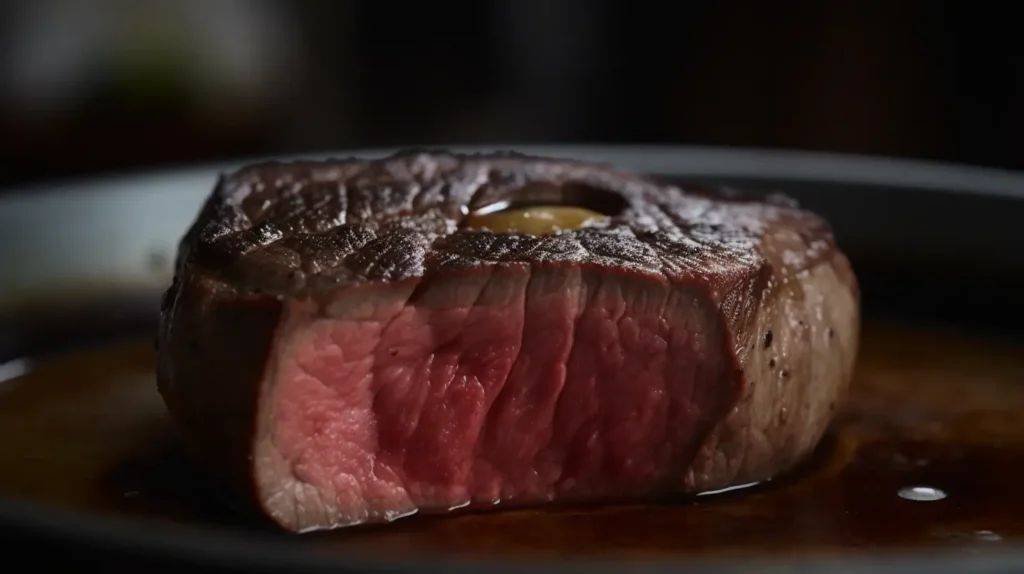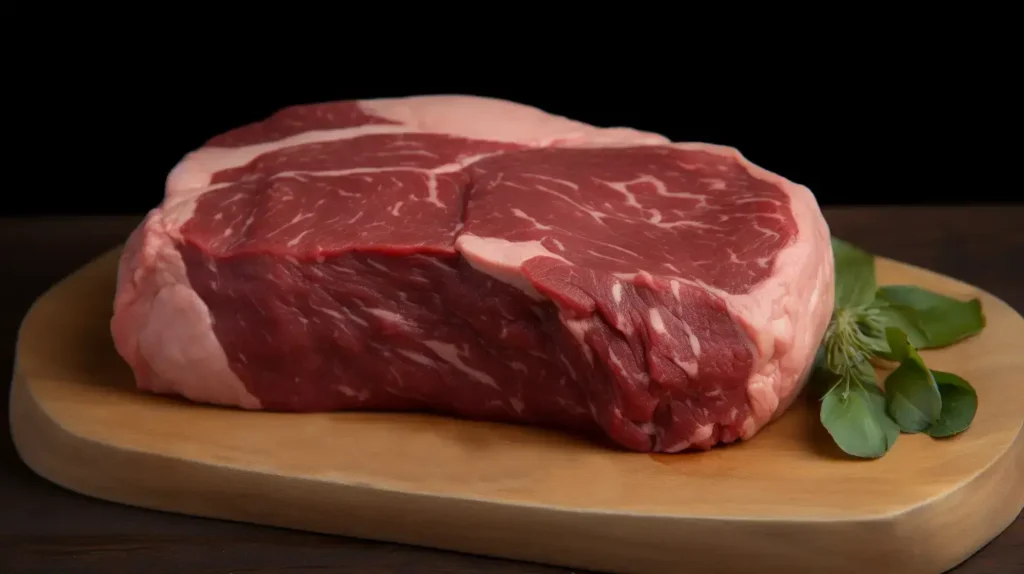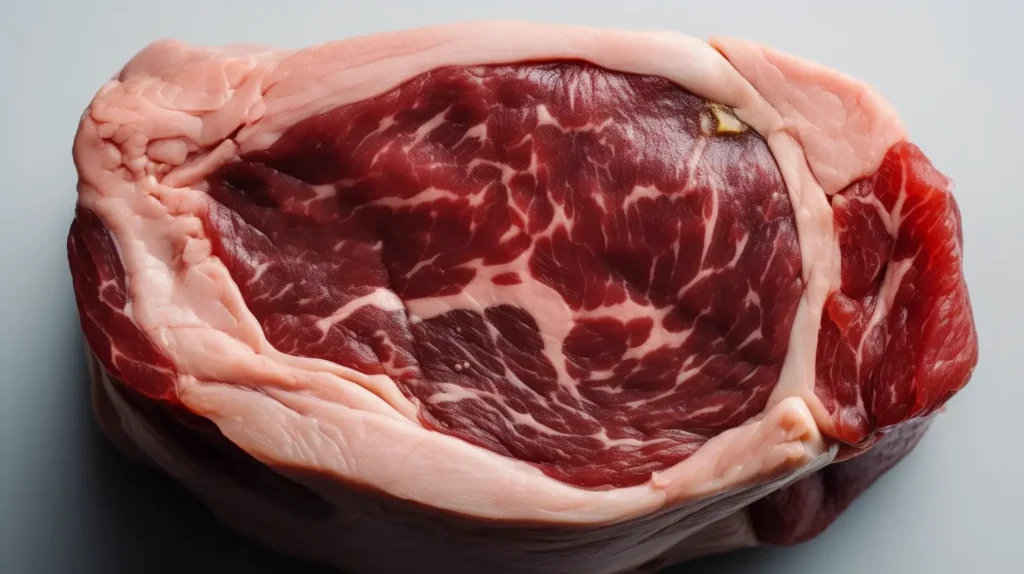Table of Contents
Chuck Eye Steak: The Budget-Friendly Alternative to Ribeye

If you’re looking for a tender, flavorful steak at a fraction of the cost of ribeye, chuck eye steak is a fantastic option. Often called the “poor man’s ribeye,” this cut comes from the fifth rib of the cow and shares many characteristics of ribeye, including rich marbling and deep beefy flavor.
Since achieving the perfect doneness is crucial for chuck eye steak, it’s helpful to refer to a steak cooking chart to match the right internal temperature with your preferred doneness. Cooking it the wrong way can result in a dry or tough steak, so using high-heat searing or grilling ensures maximum tenderness.
What Is Chuck Eye Steak?
Chuck eye steak comes from the chuck primal, which is the upper shoulder of the cow. Because it contains part of the longissimus dorsi muscle—the same muscle found in ribeye—it has a similar texture but at a lower price.
Why Choose Chuck Eye Steak?
- Affordable alternative to ribeye
- Great marbling for rich flavor
- Perfect for grilling, pan-searing, or broiling
However, because only two chuck eye steaks come from each cow, they can be harder to find in grocery stores. Check specialty butchers or online retailers for the best quality cuts.
Chuck Eye Steak vs. Ribeye: Key Differences
Both chuck eye steak and ribeye come from adjacent sections of the cow, but they have some differences:
| Feature | Chuck Eye Steak | Ribeye Steak |
|---|---|---|
| Location | Cut from the fifth rib | Cut from the sixth to twelfth ribs |
| Tenderness | Slightly firmer than ribeye | More tender with higher marbling |
| Flavor | Rich and beefy | Buttery and intensely juicy |
| Price | More affordable | More expensive |
Since chuck eye steak has less fat than ribeye, proper cooking methods help retain juiciness and tenderness.
How to Select the Best Chuck-Eye Steak
Choosing a high-quality chuck-eye steak ensures the best flavor and tenderness. Since this cut comes from the chuck primal, it’s essential to look for specific characteristics when buying it.
What to Look for in Chuck-eye Steak:
- Marbling – The more fine fat streaks throughout the meat, the juicier the steak will be.
- Bright red color – Indicates freshness and proper handling.
- Firm texture – The meat should feel slightly firm but not tough.
- Minimal connective tissue – Avoid steaks with excessive gristle or large sinewy sections.
Where to Buy Chuck Eye Steak:
- Local Butchers – Often the best place to find well-marbled cuts.
- Supermarkets – May have limited stock since only two chuck eye steaks come from each cow.
- Online Retailers – Many specialty meat suppliers ship premium chuck-eye steak straight to your door.
For the best results, buy thicker cuts (at least 1 inch), as they retain more moisture and tenderness during cooking. Always check for proper labeling to ensure you’re buying an authentic chuck-eye steak and not a lower-quality chuck cut.
How to Cook Chuck-Eye Steak Perfectly
🔥 Grilling
- Preheat the grill to 450-500°F.
- Season with salt, black pepper, and garlic powder.
- Grill for 3-4 minutes per side for medium-rare.
- Let the steak rest for 5-10 minutes before slicing.
🍳 Pan-Searing
- Use a cast iron skillet for even heat distribution.
- Heat avocado or canola oil until smoking hot.
- Sear the steak for 3-4 minutes per side.
- Baste with butter, garlic, and rosemary.
🔥 Broiling
- Set the oven to high broil.
- Place the steak 4-5 inches below the broiler.
- Broil for 4 minutes per side, flipping once.
For best results, always use a meat thermometer to check doneness.
Chuck Eye Steak Cooking Chart
Referencing a steak cooking chart ensures precision:

| Doneness | Internal Temperature | Cooking Time Per Side (1-inch Steak) |
|---|---|---|
| Rare | 120-130°F (49-54°C) | 2-3 minutes |
| Medium-Rare | 130-135°F (54-57°C) | 3-4 minutes |
| Medium | 135-145°F (57-63°C) | 4-5 minutes |
| Medium-Well | 145-155°F (63-68°C) | 5-6 minutes |
| Well-Done | 155°F+ (68°C+) | 6-8 minutes |
Best Seasonings and Marinades for Chuck-Eye Steak
🧂 Best Seasonings
- Salt & black pepper – Enhances natural beefiness.
- Garlic butter rub – Adds depth and richness.
- Smoked paprika & chili powder – Creates a smoky, spicy crust.
🍖 Best Marinades
- Soy sauce & Worcestershire mix – Enhances umami flavor.
- Olive oil, lemon juice, and herbs – Adds freshness and tenderness.
- Balsamic vinegar & honey glaze – Provides a sweet and tangy balance.
For maximum flavor, marinate the steak for at least 30 minutes before cooking.
Is Chuck Eye Steak Good for Grilling?
Chuck eye steak is an excellent choice for grilling, thanks to its marbling and rich beefy flavor. However, since it comes from the shoulder section, it is slightly leaner than ribeye, meaning proper cooking techniques are key to avoiding dryness.
How to Grill Chuck-Eye Steak:
- Preheat the grill to 450-500°F to create a perfect sear.
- Season generously with salt, pepper, and garlic powder.
- Grill each side for 3-4 minutes for medium-rare, adjusting for doneness.
- Use a meat thermometer to check for 130-135°F (medium-rare) or 140-145°F (medium).
- Let it rest for 5-10 minutes to keep the juices locked in.
Why Grilling Works Well for Chuck-Eye Steak:
- The high heat creates a crisp, flavorful crust.
- The steak’s marbling melts into the meat, enhancing tenderness.
- A quick sear prevents overcooking and keeps the steak juicy.
For even better flavor, try using a smoky dry rub or marinating the steak for an hour before grilling.
Perfect Side Dishes for Chuck-Eye Steak
Pairing chuck eye steak with the right side dishes can complete the meal.
- Parmesan Garlic Chicken Pasta – A creamy, cheesy pasta that pairs well with grilled steak.
- Grilled asparagus or roasted Brussels sprouts – Adds a fresh contrast to the rich meat.
- Organic Ramen Noodles – A unique, umami-rich pairing option.
Can You Use Chuck-Eye Steak for Stir-Fry?
Yes! Chuck eye steak is an excellent choice for stir-frying due to its rich beefy taste and ability to absorb marinades well. Unlike tougher chuck cuts, chuck eye steak remains tender when sliced thin and cooked quickly over high heat.
How to Prepare Chuck Eye Steak for Stir-Fry:
- Slice thinly (about ¼ inch thick) against the grain for maximum tenderness.
- Marinate for at least 30 minutes in soy sauce, ginger, and garlic to infuse flavor.
- Use a hot wok or skillet to sear the beef for 2-3 minutes over high heat.
- Avoid overcooking—since the slices are thin, they cook quickly.
Best Ingredients to Pair with Chuck-Eye Steak in Stir-Fry:
- Vegetables: Bell peppers, onions, broccoli, and mushrooms complement the steak’s bold flavor.
- Sauces: Oyster sauce, hoisin sauce, and sesame oil enhance the umami taste.
- Carbs: Serve with steamed rice or stir-fried noodles for a complete meal.
By using chuck eye steak in stir-fry, you get a quick, protein-packed meal without the cost of pricier cuts like ribeye.
How to Make Chuck Eye Steak More Tender
Although chuck eye steak is one of the most tender cuts from the chuck primal, it still benefits from a few tenderizing techniques to improve its texture.
Best Ways to Tenderize Chuck Eye Steak:
- Salt Dry Brine – Coat the steak with coarse salt and let it rest for at least 45 minutes before cooking. This draws moisture to the surface and breaks down muscle fibers.
- Marinating – Use acidic ingredients like lemon juice, vinegar, or yogurt to naturally soften the meat.
- Meat Mallet – Lightly pound the steak with a meat tenderizer to break down connective tissues.
- Slow Cooking (Alternative Method) – If grilling or pan-searing isn’t an option, slow-cooking chuck-eye steak in broth or wine at a low temperature can produce a fork-tender result.
Why Tenderizing Matters:
- Prevents chewy texture in leaner sections.
- Allows seasonings and marinades to penetrate more effectively.
- Helps achieve a juicy, melt-in-your-mouth bite.
Even though chuck eye steak is naturally flavorful, taking the time to tenderize it will make a noticeable difference in your final dish.
Why Chuck Eye Steak Is a Great Choice for Meal Prepping
If you’re looking for a protein-rich option for meal prep, chuck eye steak is an excellent choice. It stays flavorful even when reheated, making it perfect for make-ahead meals.
Benefits of Using Chuck Eye Steak for Meal Prep:
- Affordable and high in protein – Great for budget-conscious eaters.
- Pair well with many side dishes – Serve it with rice, vegetables, or pasta.
- Easy to cook in batches – Grill or pan-sear multiple steaks at once.
How to Store Chuck Eye Steak Meal Preps:
- Refrigerate cooked steak in airtight containers for up to 4 days.
- Freeze portions in vacuum-sealed bags for up to 3 months.
- Reheat properly – Use a low heat method (oven or skillet) to prevent the steak from drying out.
For a quick, protein-packed meal, slice the steak and serve it over a fresh salad, or mix it into stir-fried noodles for a fast and easy lunch.

FAQs About Chuck Eye Steak
Is Chuck Eye Steak as Good as Ribeye?
Yes, Chuck Eye Steak is a great affordable alternative to ribeye. While it has slightly less marbling, it still delivers a rich, beefy flavor when cooked correctly.
Is Chuck Eye Steak Tough or Tender?
Chuck eye steak is more tender than other chuck cuts but slightly firmer than ribeye. Cooking it over high heat and avoiding overcooking helps keep it juicy.
Is Chuck Eye a Good Cut of Steak?
Yes, it is an excellent cut for those looking for ribeye-like flavor at a more affordable price. It comes from the chuck primal, specifically near the rib section, making it more tender than other chuck cuts. Due to its natural marbling, it remains juicy and flavorful when cooked correctly.
Although it’s not as buttery soft as ribeye, chuck eye steak delivers a rich, beefy taste that works well for grilling, pan-searing, and broiling. Since there are only two chuck eye steaks per cow, it’s somewhat rare to find, but when available, it’s an affordable, high-quality alternative to more expensive cuts.
For the best results, cook chuck-eye steak over high heat, season it well, and allow it to rest before slicing. With the right preparation, it can be just as delicious as premium cuts at a fraction of the price.
How Should Chuck Eye Steak Be Stored?
- Refrigeration: Store raw chuck-eye steak in the fridge for 3-5 days.
- Freezing: Wrap tightly and freeze for up to 3 months.
- Thawing: Always thaw in the refrigerator overnight.
What Is the Best Way to Tenderize Chuck Eye Steak?
To improve tenderness, use a dry brine with salt or marinate with acidic ingredients like lemon juice or vinegar. Let the steak sit at room temperature before cooking.
What’s Another Name for Chuck Eye Steak?
Chuck eye steak is often called the “poor man’s ribeye” because it shares many characteristics with ribeye steak but is available at a lower cost. Since it comes from the same primal section as ribeye, it has similar marbling and tenderness when cooked correctly.
In some butcher shops or grocery stores, you may also see it labeled as:
- Chuck Delmonico Steak – A reference to its tender texture, resembling Delmonico-style steaks.
- Boneless Chuck Fillet – Highlighting the fact that it is a boneless cut.
- Chuck Eye Roll Steak – A name that references its location in the Chuck Primal.
While it’s important to verify the exact cut with your butcher, chuck eye steak is a great substitute for ribeye and offers excellent flavor when grilled, pan-seared, or broiled.
What’s the Best Way to Cook Chuck Eye?
The best way to cook chuck-eye steak is over high heat using methods like grilling, pan-searing, or broiling. Since it has moderate marbling, cooking it quickly at a high temperature helps retain juiciness while developing a rich crust.
Steps for Cooking Chuck Eye Steak:
- Bring to room temperature – Let the steak sit out for 30 minutes before cooking.
- Season well – Use salt, black pepper, and garlic powder for a bold flavor.
- Use high heat – Preheat a grill or cast iron skillet until very hot.
- Sear each side for 3-4 minutes – This creates a flavorful crust while keeping the inside tender.
- Let it rest – Allow the steak to rest for 5-10 minutes before slicing.
For extra tenderness, marinate the steak for at least 30 minutes or baste it with butter and herbs during cooking.
Why Is Chuck Eye Steak So Cheap?
Chuck eye steak is more affordable than premium cuts like ribeye because it comes from the chuck primal, which is typically used for slow-cooked dishes rather than steaks. Since only two chuck eye steaks per cow are suitable for grilling, they are less commonly available than ribeye, but their lower demand keeps the price down.
Despite its rich beefy flavor and decent marbling, chuck eye steak is considered less premium because it contains slightly more connective tissue and is not as consistently tender as ribeye. However, with the right cooking method, it can be just as delicious as higher-priced cuts.
For budget-conscious steak lovers, chuck eye steak is an excellent alternative, providing great taste, juiciness, and versatility at a fraction of the cost of premium steaks.
Final Thoughts
Chuck eye steak is a versatile, budget-friendly cut that offers ribeye-like flavor at a much lower price. Whether you’re grilling, pan-searing, stir-frying, or meal-prepping, this steak delivers rich taste and tenderness with the right cooking techniques. By using a steak cooking chart, proper seasoning, and avoiding common mistakes, you can create restaurant-quality meals at home.
🔥 Now it’s time to cook the perfect chuck-eye steak! 🔥